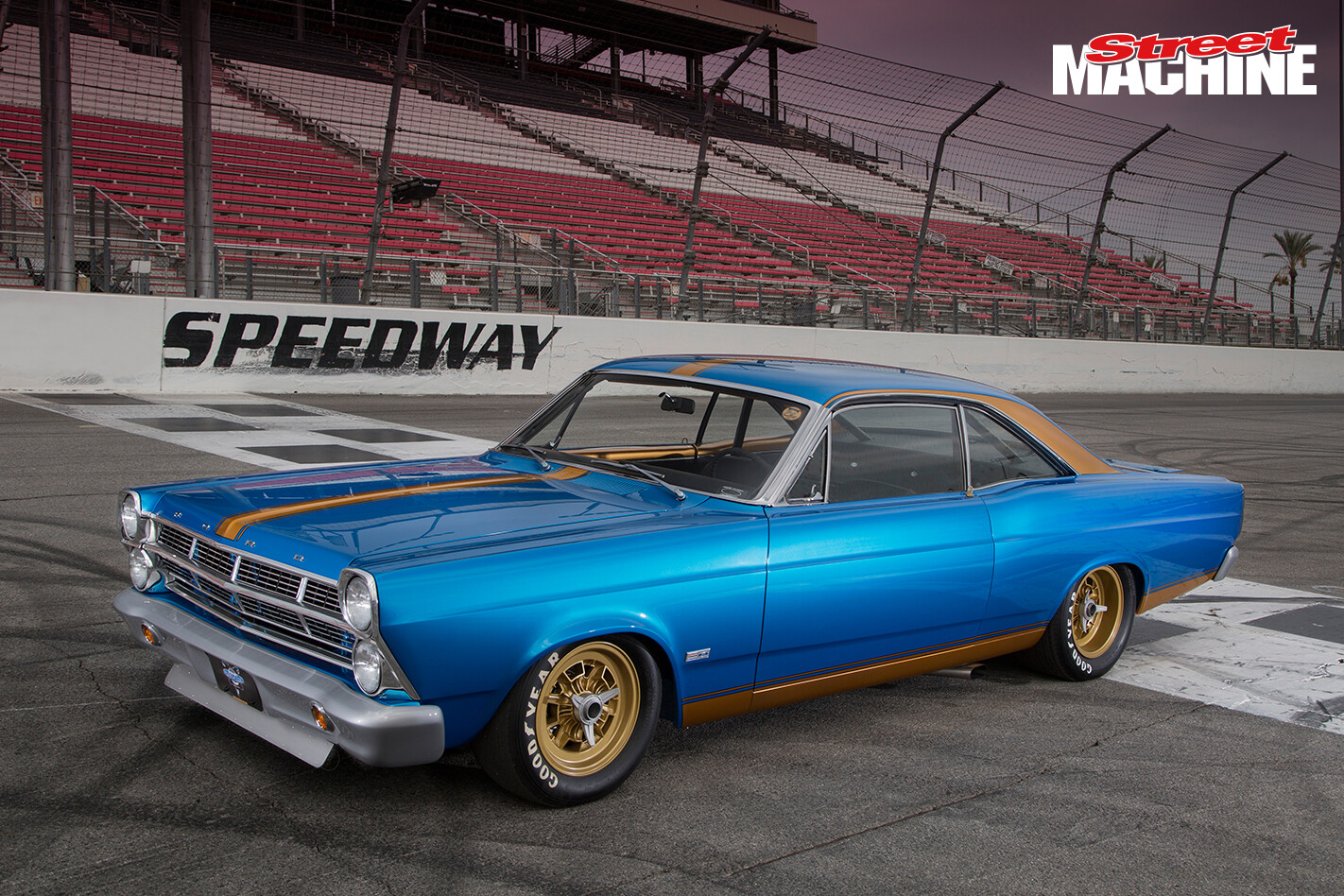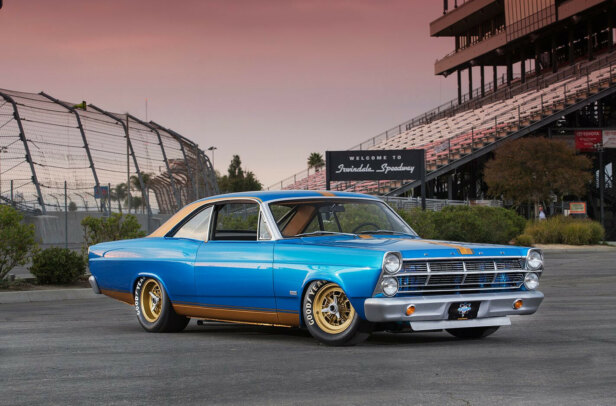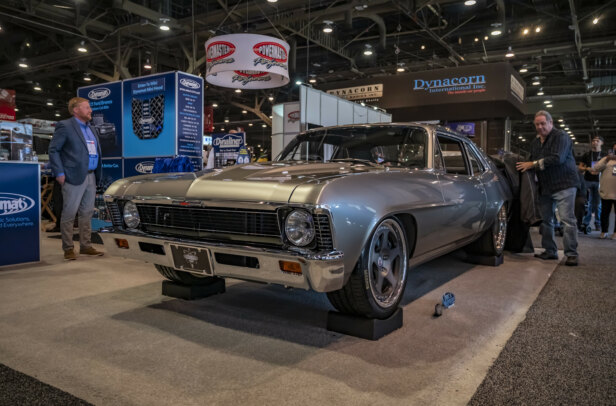THIS 1967 Fairlane is the latest SEMA-stopping build from Steve Strope and his team at the renowned Pure Vision fabrication shop in California. They’ve gone to breathtaking lengths just to make their hand-built one-of-a-kind tribute to Ford’s Total Performance engineers look like a standard machine.
“I nicknamed this the Black Ops Fairlane,” Steve says. “I try to have a theme or a central idea to hinge my builds off, and Street Machine readers will remember the Martini Mustang, which had an obvious theme of Ford building a prototype road-rally car in conjunction with Martini.
“For the Fairlane we envisioned a secret test group of engineers inside Ford called The Black Ops, and this car would be a performance data acquisition vehicle. That means they’d use this solely for testing and learning, because the Fairlane was the platform Ford used in NHRA drag racing and NASCAR. But, of course, both those sanctioning bodies have rules – ‘you can’t do this, you can only do that’.
“So this car isn’t chained down by those rules, which lets us have driver-activated aero, adjustable torsion bar suspension, illegal motors, different or illegal intakes, aerodynamic smoothing and lots of different little things that the Black Ops engineers can learn from and put that knowledge towards the cars that are constrained.”
Starting with the body, the rear wheelarches have been radiused, as was done on the NASCARs of the time, and the inner guards replaced to improve tyre clearance. All the suspension mounting points have been massively reinforced, with 2×4 box welded in under the sill to stiffen the body and large plates used to reinforce the floor under the pedals. Strope and the boys also added a Mustang transmission tunnel and mount for the Top Loader gearbox, to avoid the ugly lump many Fairlane owners have to create when fitting one of Ford’s legendarily tough four-speed manuals.
As 60s Ford fans know all too well, the shock towers up front also pose a clearance problem. However, rather than just cutting them out and sheeting over the top, Strope and his team sectioned and shrunk the towers to keep a familiar look to the Fairlane’s engine bay. Underneath, drop spindles from Fatman Fabrication and control arms from Global West were used, with a heavily customised triangulated Heidts four-link in the rear.
After that though, things get decidedly exotic for the Black Ops’ suspension. In the rear the chassis rails were straightened to work around the crazy Indy-style adjustable torsion bar suspension that now lives in the boot, boxing in the batteries.
“I work with Gary Schroeder from Schroeder Racing,” Steve says. “He and his family have been doing torsion bar suspension for generations, literally decades, and I wanted to utilise that because it would allow me to hide a lot of the suspension.
“The front torsion bars go through the frame rails and exit through notches behind the chrome-moly control arms. The rear bars sit in the trunk and have links that go down through the frame rails and tie on to the top of the Speedway Engineering Super Max diff.
“This all ties back to the idea that the car was a test vehicle, because they can change torsion bar stiffness or alter ride height really easily; they don’t have to mess around with coil springs. It also tidied up underneath the car and, even though he wasn’t a Ford guy, legendary NASCAR engineer Smokey Yunick was big on removing as much stuff from the bottom of the car as possible as it helps the air.
“It also let me remove a lot of meat from the shock towers to make room for that massive SOHC motor, which was an extra benefit. We did the bars and all said: ‘Wow, thank goodness we did that, because those new towers are really going to help out!’”
While Ford was never allowed to run the overhead-cam 427, Steve figured they’d test it out in a data car like Black Ops.
“The engine is an all-aluminium 427 SOHC motor, built by Ed Pink,” Steve says. “It’s topped with four two-barrel Holley carburettors on a unique intake manifold that I wanted to have look like a prototype. Aron Cranford from Ace’d Auto Worx made a killer set of tube headers that replicate a side-by-side design used on Holman-Moody stock cars from the period.
“We finished the rear end off with a Super Max quick-change from Speedway Engineering, again because we figured they were testing stuff and would need to change ratios quickly.”
Inside the Fairlane is simplicity itself: low-rise buckets, simple four-point retro rollcage and welded-up, sectioned dashboard, which is now filled with vintage-look Speedhut gauges. The steering column is a shortened Flaming River unit with no electronics in it, as all those outputs now run off dash-mounted switchgear.
“I try very hard to include a lot of small details,” Steve says. “I call it ‘the Easter egg hunt’. The first things you see on my car stand out, like the Lamborghini Miura wheels, or that wing. But there’s many more things you actually find as you look around the car. The key for me is restraint and trying to make sure everything works together so the car makes the statement, not just the wing or the wheel.
“When people say: ‘I come back and find things after the third, fourth, fifth time’, that means I did my job right as the designer, and my team and I did our job right as the builders.
“Everything is cohesive, everything looks as if it belongs and nothing sticks out like a sore thumb. The 427 actually has a hand-made, one-of-a-kind intake but nobody looked at it and went: ‘Oh my gosh; what is that weird thing?’ It looks like an old 60s performance cast aluminium manifold that some guy probably found in a rare collection, and that’s good because that is exactly how I wanted you to see it.”




Comments